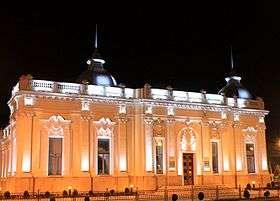Baku Puppet Theatre
The Baku Puppet Theatre (formally Azerbaijan State Puppet Theatre named after Abdulla Shaig , Azerbaijani: Abdulla Şaiq adına Azərbaycan Dövlət Kukla Teatrı) is located on Neftchiler Avenue of Baku. It was built in 1910 by Polish architect Józef Płoszko, initially as the French Renaissance "Phenomenon" movie theater.[1]
"Phenomenon", "Satyragite" | |
 | |

| |
| Address | Neftchilar Avenue, 36 Baku Azerbaijan |
|---|---|
| Coordinates | 40°22′2.04″N 49°50′21.17″E |
| Public transit | M 1 Sahil metro station |
| Type | Puppet theatre |
| Capacity | 210 seats |
| Construction | |
| Rebuilt | 1921 |
| Years active | Since 1931 |
| Architect | Józef Płoszko |
The puppets vary in size from a few centimetres to double the size of a human.[2]
Overview
The theatre building was erected at the Baku Boulevard when there was no greenery yet. The exhaust ventilation system was superseded by forced ventilation. When the movie theater was opened to the public in June 1910, its administration advertised the features of full air change, occurring every 15 minutes and special ozonator.[1]
Auditorium hall of the movie theater was 24 m. in length, 11 m. in width, 10 m. in height. 400 seats were available in parterre. Additionally there were 7 loges, and in upper section 3 verandas.[3]
History
History of the building
The first owner of “Phenomenon” cinema was M.Gofman. It was planning to rent the cinema hall for spectacles. Entrepreneurs were arranging a permission from city authorities to enlarge the building in the future. As a result, the architectural appearance of the building was completed by the monuments of 4 ancient mythological figures – Mercury, Bacchus, Poseidon and Aphrodite.[3]
In 1921, according to project of Azerbaijani architect Zivar bey Ahmadbeyov the building was cardinally rebuilt for theatre "Satyragite".[4]
“Phenomenon” operated as cinema, casino, Satyrogite theatre, Musical Comedy Theater and Museum of Agricultural Achievements till 1931.[5]
History of Puppet Theatre
The idea to establish Puppet Theatre in state level was introduced by the organizer of Theater Museum, actor Molla Agha Babirli. On the initiative of theater activists led by Jafar Jabbarly, Puppet Theatre was founded in 1931 by the decision of Education Commission.[3] The first spectacle of the Theatre was “Circus” played in 1932.[5]
Puppet Theatre operated independently in 1931-1941, and in 1946-1950, under Azerbaijan State Theatre of Young Spectators in 1941-1946 and Azerbaijan State Philharmonic Hall in 1950. In 1964 “State” status was given to the theatre.[5]
Since 1975 plays for adult audience have been performing as well.[5]
See also
References
- (Russian)Ш.С. Фатуллаев. Градостроительство и архитектура Азербайджана XIX-начала XX века, Ленинград, 1986, с. 229
- "Puppet Theatre". City Life.az. Archived from the original on 2013-02-23. Retrieved 2010-05-16.
- "History". Seaside Boulevard Office. Archived from the original on 17 March 2018. Retrieved 10 May 2017.
- Фатуллаев, с. 231
- "About Theatre-History". Azerbaijan State Puppet Theatre named after A.Shaig. Archived from the original on 2017-11-01. Retrieved 10 May 2017.
External links
| Wikimedia Commons has media related to Baku Puppet Theatre. |
- Azerbaijan State Puppet Theatre (official website)
- Seaside Boulevard Office (official website)